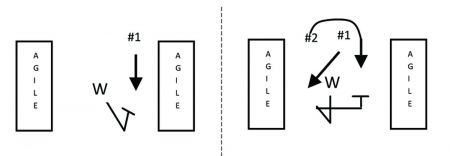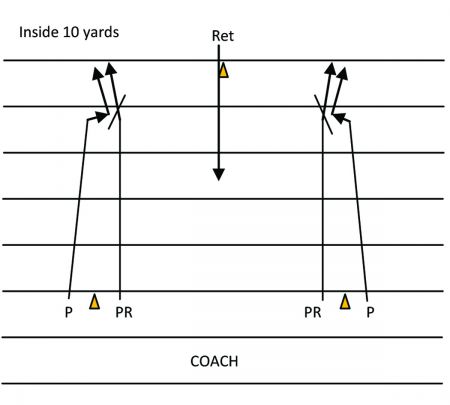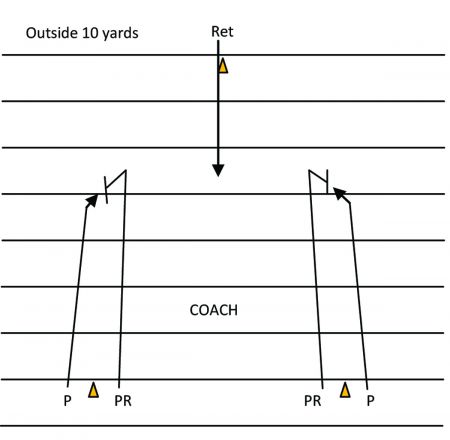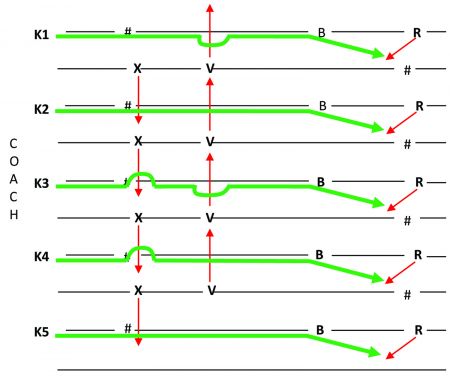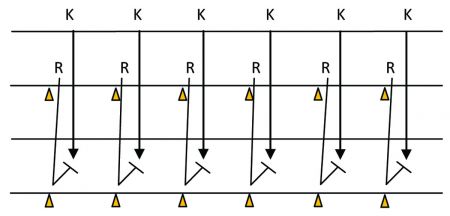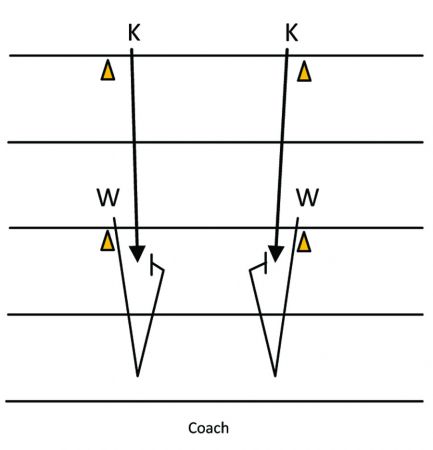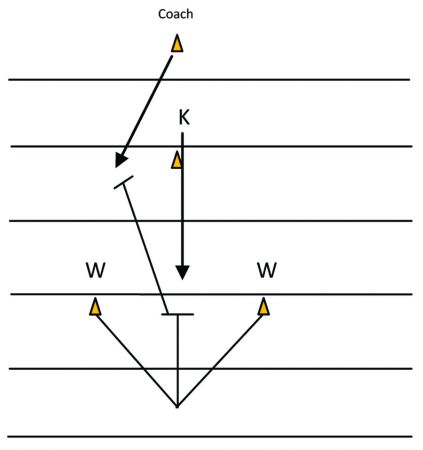Article CategoriesAFM Magazine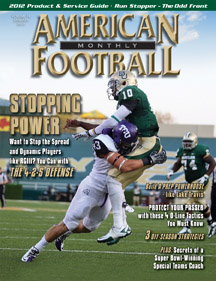
|
Drills Report – EXPANDED – Special Teams at South Dakota Stateby: Shannon TurleyDirector of Athletic Performance Training, University of San Diego © More from this issue I have had the opportunity to work as the special teams coordinator at South Dakota State for the past two seasons. During that time, I could not be more pleased with our success. In 2010, we ranked No. 4 in FCS net punting, No. 4 in punt return yardage defense, No. 9 in kickoff returns, No. 1 in kickoff return yardage defense and No. 37 in punt returns. We accomplished these numbers without placing one single player in the top-20 of any category. I truly believe we achieved that success because of three things: During our pre-practice time (nine minutes), we work all of the basic fundamentals of special teams. Long snappers, punters and punt returners work together. Short snappers, holders and kickers work together. Kickers kick to kickoff returners, and all other players work on their punt team footwork. We end this session with what we call the “three-man drill.” We align our field goal unit up against our field goal block unit and kick field goals with interior players taking one step to their gaps and with the edge players attempting to block the kick. We want to get six kicks off in a three-minute span and we chart and time all of them. This allows us to work our edge blocking, timing and fire calls every day in a short amount of time. The punt unit’s first day of drills consists of 1-on-1s, 2-on-1s and releases. We primarily operate as a man team, but we do have calls and adjustments to put us into zone protection. We have four different groups divided up by their positions. Our punter, personal protector (PP) and snapper make up one group, with our right and left sides representing groups two and three. Our fourth group, which consists of our outside guys (stingers), work releases and a finish drill (squeezing the returner with their inside shoulder). In the snapping drills, we tell our snapper which direction we will kick to, and our PP plays off of him. The snapper snaps and the punter punts on every rep. We place the agile bags three yards apart to make the spacing realistic. Our snapper and PP are working man and zone principles. They are responsible for the defenders that come through the ‘A’ gap. All other players are assigned to a specific man. In diagram 1, our snapper and PP will work their respective gap and block their man. In diagram 2, our snapper and PP will work their respective gap and block their man. In diagram 3, our snapper will block the nearest defender and not worry about the cross-face defender. Our PP knows that he has the player the snapper will not take so he will go across the formation to pick him up. In diagram 4, our snapper will stay in his gap. We do not want him to wheel back and take the cross face. He knows the PP will slide over and pick him up. However, if he does go with him, our PP will adjust and pick up the right side rusher like he did in diagram 1.
Our right and left side groups work a very similar drill. In the diagram below, I drew up the right side of the drill. We set up the left side the same way, using the same techniques, with the only difference being their stance. The wings take a rep, followed by the tackles and ending with the guards. We set these agile bags two yards apart. Diagram 5 shows the wing taking on the block 1-on-1. In our 2-on-1 drill, our wing’s responsibility is the final #1. If his original #1 crosses his face, he will wash him down with his eyes inside. If he gets a twist, he will come off and pick up the twister (#2) who becomes the final #1. The tackle will pick up the slant (#1) since he will become the final #2 in our pick-up rules (Diagram 6).
Diagram 5. Diagram 6. With our punt return unit, our first practice consists of three different stations. We have a hold up station, a downfield blocking station that occurs within 10 yards of the returner and a downfield blocking station that occurs outside of 10 yards from the returner. For the downfield blocking station drills, you can start the returner 25 yards down the field with the coach giving a ‘go’ cadence and then throw the ball to the returner. On ‘go’ the punt cover man will begin working down the field. As the ball is caught, he will look to squeeze the returner, keeping him on his inside shoulder. As the returner catches the ball, the punt cover man wants to plant and work in towards the returner. The PR man works downfield in a trail technique (1 yard inside and 1 yard behind) on the punt cover man. As the ball is caught, the PR man will be within 10 yards of the returner. As the punt cover man angles in, the PR man will rip through his inside arm, cut him off, and keep running with the punt cover man on his hip. Stress to your PR man not over-run the punt cover man. Do not let him get behind you. The returner will catch the ball and get vertical up the field and split the blockers. We will use the players we have targeted as our returners so they get used to seeing the blocks in front of them (See Diagram 7).
Diagram 7. If you start the returner 35 yards down the field, much of the assignments are the same. However, as the returner gets up the field, the PR man will look to plant, open up to the punt cover man, and stalk block him. We want to make sure he stays on their upfield shoulder so he is forced to go around and end up chasing the returner back up the field (See Diagram 8).
Diagram 8 The last drill station that we work with our punt return unit is our hold-up station (Diagram 9). We can run this as a 1-on-1, 2-on-2 or 3-on-3 drill. On the first day we usually do 2-on-2. Here are the coaching points:
Diagram 9. - We want to start in a sprinters stance and fire off the ball like we are going to block the kick.
Diagram 10. Responsibilities: The final unit to talk about is our kickoff return. We run a six-man front line; three in the wedge, and a two returner man-scheme. We run right and left sideline returns and a middle return. We can make two or three adjustments off of each return if we need to use those in our game plan. Our front line and our wedge work two different drills during our first day practice time.
Diagram 11 In our first front line drill (Diagram 11) we line up our KO players (K) five yards from our front-line players (R) and have a set of cones with our front-line players and another set 10 yards behind them. We want these players to stalk block which is what these groups do daily in practice. At the whistle, the front line will turn and sprint back ten yards with the KO players running at 75% down the field. We want our front line guys to shade the KO player about a yard inside to block him away from the return. We want to get on the upfield shoulder and maintain inside leverage.
Diagram 12. In our second front line drill (Diagram 12) we will have our players that we designate as double team players that will work this drill. In this drill, we stagger our tackles in a 5x5 alignment from our TEs. At the whistle, the tackles will run back to the cones and it is the TE’s responsibility to get shoulder-to-shoulder with him. They will look to double team the KO player to the kicker or safety. The double team players most important rule is that the KO player cannot get outside the hash. If he runs inside of the double team, then the TE will climb to the kicker/safety and the tackle will block the KO player as he did in diagram 11.
Diagram 13. With our wedge, we work a 2-on-2 drill and also a double team drill (Diagram 13). We put our wedge (W) and KO players (K) ten yards apart, On the cadence, the wedge drops back 7-8 yards maintaining the appropriate two yards distance between each other. On the coaches ‘kick’ call, the wedge players take off and get set up. On the coaches ‘go’ call, the KO players will work down the field and the wedge will attack the KO players just like they would on a ‘go’ call on a live kick. The wedge must maintain an inside leverage alignment and kick out the KO players.
Diagram 14. Our double team drill (Diagram 14) puts two wedge players in the same spot as the previous drill. We stack the KO players 10 and 18 yards from the wedge splitting them. On the ‘kick’ call, the wedge will drop back and get shoulder to shoulder. On the coaches ‘go’ call, the KO player will run at the double and the wedge will attack the KO player. When contact is made, the coach will go either right or left at a 45-degree angle. The wedge player to the coaches side will come off the double team and kick out the coach. The opposite wedge player will then take over the block on the KO player. Our kickoff returners work on catching kicks and communicating with each other during day one. Kickers only kick lob-type kicks so we can save their legs and also get plenty of work in at the same time. Each one of the drills that I discussed is a day one drill for each unit (we run FG vs. FG block every day in pre-practice). We usually do three full days of drills (15-20 minutes each day) leaving the next two days of drills as a continuation of these drills and adjustments off of them. I hope you can take something away from this and incorporate it into your special teams. |
|
| HOME |
MAGAZINE |
SUBSCRIBE | ONLINE COLUMNISTS | COACHING VIDEOS |
Copyright 2024, AmericanFootballMonthly.com
All Rights Reserved



